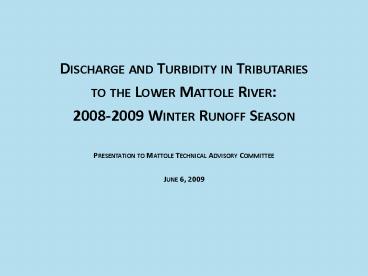Discharge and Turbidity in Tributaries PowerPoint PPT Presentation
1 / 15
Title: Discharge and Turbidity in Tributaries
1
- Discharge and Turbidity in Tributaries
- to the Lower Mattole River
- 2008-2009 Winter Runoff Season
- Presentation to Mattole Technical Advisory
Committee - June 6, 2009
2
Turbidity Lower Bound Lines Figures from
Klein, R.D., Trush, W.J., and M. Buffleben.
2008. Watershed Condition, Turbidity, and
Implications for Anadromous Salmonids in North
Coastal California Streams. A Report to the
California Northcoast Regional Water Quality
Control Board, Santa Rosa, CA. 105 p.
3
Figure from Klein, R.D., Trush, W.J., and M.
Buffleben. 2008. Watershed Condition, Turbidity,
and Implications for Anadromous Salmonids in
North Coastal California Streams. A Report to the
California Northcoast Regional Water Quality
Control Board, Santa Rosa, CA. 105 p.
- Points along lower edge of plot generally from
recessional storm flows - Recessional stormflows longer duration than
accessional stormflows - Slope of lower bound line indicative of chronic
turbidity - Relatively insensitive to climatic variation
- Possible to define with targeted manual sampling?
4
Study objectives
- Determine effects on tributary water quality
attributable to road treatments - Determine the need for and nature of any
modifications to the style or rate of road
treatments that may be warranted to reduce water
quality impacts
5
Criteria for Sampling Site Selection
- level of landowner cooperation (inventory access
to gt80 of the basin) - similarly small drainage areas (lt2.5 sq mi)
- ease of winter access
- range of magnitude of planned road treatments
(especially more cy/sq mi to be treated)
6
(No Transcript)
7
Methods
- Install staff/crest gages, survey cross-sections
- Take sufficient discharge measurements to develop
discharge rating curve
- Targeted grab sampling for turbidity on
recessional flows following storm events (gt.75
rain in six hours) - Collect and analyze at least 40 turbidity
samples/site
8
Data Analysis
- Develop discharge rating curves for each site
- Plot unit discharge (cfs/sq mi) against turbidity
(NTRU) - Fit lower bound lines (LBLs) to scattergrams
- Compare slope of LBLs among sites
- Compare slope of LBLs pre- and post-treatment
9
Results
10
Results
11
Results
12
Results
13
Issues Affecting Data Quality
- Shaky LBL at NSEM
- Changes in cross-sections at staff gages
- Timing of sampling at lower turbidities
significance of y-intercept
14
Issues and questions
- Changes in implementation schedule and landowner
cooperation another pre-treatment year and
additional controls - Many sediment treatments preventative may not
see response until stressing event - How many samples are necessary?
- Cut costs through changes in sampling schedule?
- Sampling by volunteers/landowners?
15
Acknowledgements
- Thanks to the field crews who worked cheerily and
intently through long wet hours on short notice
in the rain - Thanks to Randy Klein for data analysis and
technical guidance - Thanks to the SWRCB, and Janet Blake, grant
manager, for funding and support

